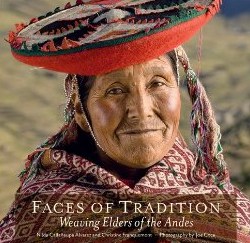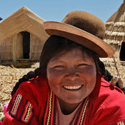
The idea for this book was a result of a gathering of weavers at the Center for Traditional Textiles of Cusco (CTTC). Afterwards, three friends who attended the soirée chose to produce the book, in honor of the Elders with their portraits after the discussion that one would remember the Elders faces the most. After tenderly turning each page like an Alice Paul suffragist scrapbook, one discovered a helpful map of the small community in the Andes Mountains denoting each of the nine villages involved with the CTTC where the Elders, who have earned their titles by living properly, dwell. At the closing of the book is a glossary of Quechua (the language of the region) terms pertaining to designs, animals, food, festivals and weaves. The pages in between are richly and respectably written to honor the Elders who have learned their passed down craft for survival and enjoyment.
Each chapter contained nuggets of information about gender roles or the impact of land reform and customs. They also identified Elders from the community with a portrait and a brief biography of their life describing their hardships and the influence of textiles in their lives. Their faces usually lacked expressions under their sun protecting hats, ranging from a dusty brown to a yellow bread basket looking hat called monteras. Their shoulders contained a woven shawl designed with their traditional weave and design. A large silver pin held together their shawl and occasionally, tucked into their belt was a dowel with yarn for spinning while walking or herding livestock. The book described the tweaked designs, colors or added letters and numbers of each village incorporated into their textiles. Most of the Elders are women and most are widowed. All have hard life stories, though each textile was made for a specific reason-a wedding, one of the dwindling elaborate festivals, warmth or trade.
This book is a lovely tribute to the Elders who have taught and shown what was once a dying art and tradition to their family and community. The CTTC has been instrumental in supporting preservation and the continuation of that heritage for the community. I do recommend to gently pick up this book with museum quality archiving gloves (because the images are that beautiful), crawl under your patchwork quilt or afghan your Grandmother passed onto you and learn about the superstitions, techniques and the persistence of these Elders who lived and worked yesteryear and today without modern technology.
Disclosure: A free copy of this book was given to a volunteer with the expectation that a fair and honest review would be written for it.

 Book Review: “Drive Nacho Drive” by Brad & Sheena Van Orden
Book Review: “Drive Nacho Drive” by Brad & Sheena Van Orden Book review: Socialist Dreams and Beauty Queens ( A Couchsurfer’s Memoir of Venezuela) by Jamie Maslin
Book review: Socialist Dreams and Beauty Queens ( A Couchsurfer’s Memoir of Venezuela) by Jamie Maslin Book Review: In the Shadow of the Volcano by Maureen Klovers
Book Review: In the Shadow of the Volcano by Maureen Klovers Review: Los Angeles to Buenos Aires by Serdar Sunny Unal
Review: Los Angeles to Buenos Aires by Serdar Sunny Unal

